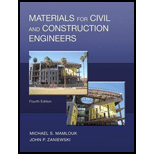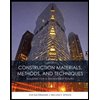
Materials for Civil and Construction Engineers (4th Edition)
4th Edition
ISBN: 9780134320533
Author: Michael S. Mamlouk, John P. Zaniewski
Publisher: PEARSON
expand_more
expand_more
format_list_bulleted
Concept explainers
Textbook Question
Chapter 1, Problem 1.50QP
Briefly discuss the concept behind each of the following measuring devices:
a. LVDT
b. strain gauge
c. proving ring
d. load cell
Expert Solution & Answer
Want to see the full answer?
Check out a sample textbook solution
Students have asked these similar questions
4.12 A 400 m vertical curve connects a -2.00% grade to a +4.00% grade. The P.I. is located
at station 150 + 00 and elevation 60.00 m above sea level. A pipe is to be located at
the low point on the vertical curve. The roadway at this point consists of two 3.6 m
lanes with a normal crown slope of 2%. If the lowest point on the surface of the road-
way must clear the pipe by 0.75 m, what is the station and maximum elevation of the
pipe?
=7.5 in., d1 = 1.5 in., b2 = 0.75 in., d2= 6.0 in., b3 = 3.0 in., and d3 = 2.0 in. Determine (a) the centroid location in inches from the
bottom surface. Round off to two decimal places.
M
H
b₂
y
...
d₁
M
by
dy
X
Vehicles arrive at a single park-entrance booth where a brochure is distributed. At 8 A.M., there are 20 vehicles in the queue and vehicles continue to arrive at the deterministic rate of λ(t) = 4.2 − 0.1t, where λ(t) is in vehicles per minute and t is in minutes after 8:00 A.M. From 8 A.M. until 8:10 A.M., vehicles are served at a constant deterministic rate of three per minute. Starting at 8:10 A.M., another brochure-distributing person is added and the brochure-service rate increases to six per minute (still
Chapter 1 Solutions
Materials for Civil and Construction Engineers (4th Edition)
Ch. 1 - State three examples of a static load application...Ch. 1 - A material has the stressstrain behavior shown in...Ch. 1 - A tensile load of 50.000 lb is applied to a metal...Ch. 1 - A tensile load of 190 kN is applied to a round...Ch. 1 - A cylinder with a 6.0 in. diameter and 12.0 in....Ch. 1 - A metal rod with 0.5 inch diameter is subjected to...Ch. 1 - A rectangular block of aluminum 30 mm 60 mm 90...Ch. 1 - A plastic cube with a 4 in. 4 in. 4 in. is...Ch. 1 - A material has a stressstrain relationship that...Ch. 1 - On a graph, show the stressstrain relationship...
Ch. 1 - The rectangular block shown in Figure P1.11 is...Ch. 1 - The rectangular metal block shown in Figure P1.11...Ch. 1 - A cylindrical rod with a length of 380 mm and a...Ch. 1 - A cylindrical rod with a radius of 0.3 in. and a...Ch. 1 - A cylindrical rod with a diameter of 15.24 mm and...Ch. 1 - The stressstrain relationship shown in Figure...Ch. 1 - A tension test performed on a metal specimen to...Ch. 1 - An alloy has a yield strength of 41 ksi, a tensile...Ch. 1 - Prob. 1.21QPCh. 1 - Figure P1.22 shows (i) elasticperfectly plastic...Ch. 1 - An elastoplastic material with strain hardening...Ch. 1 - A brace alloy rod having a cross sectional area of...Ch. 1 - A brass alloy rod having a cross sectional area of...Ch. 1 - A copper rod with a diameter of 19 mm, modulus of...Ch. 1 - A copper rod with a diameter of 0.5 in., modulus...Ch. 1 - Define the following material behavior and provide...Ch. 1 - An asphalt concrete cylindrical specimen with a...Ch. 1 - What are the differences between modulus of...Ch. 1 - Prob. 1.33QPCh. 1 - A metal rod having a diameter of 10 mm is...Ch. 1 - What is the factor of safety? On what basis is its...Ch. 1 - Prob. 1.36QPCh. 1 - Prob. 1.37QPCh. 1 - A steel rod, which is free to move, has a length...Ch. 1 - In Problem 1.38, if the rod is snugly fitted...Ch. 1 - A 4-m-long steel plate with a rectangular cross...Ch. 1 - Estimate the tensile strength required to prevent...Ch. 1 - Prob. 1.42QPCh. 1 - Briefly discuss the variability of construction...Ch. 1 - In order to evaluate the properties of a material,...Ch. 1 - A contractor claims that the mean compressive...Ch. 1 - A contractor claims that the mean compressive...Ch. 1 - Prob. 1.47QPCh. 1 - Prob. 1.48QPCh. 1 - Prob. 1.49QPCh. 1 - Briefly discuss the concept behind each of the...Ch. 1 - Referring to the dial gauge shown in Figure P1.51,...Ch. 1 - Repeat Problem 1.51 using the dial gauge shown in...Ch. 1 - Measurements should be reported to the nearest...Ch. 1 - During calibration of an LVDT, the data shown in...Ch. 1 - During calibration of an LVDT, the data shown in...
Knowledge Booster
Learn more about
Need a deep-dive on the concept behind this application? Look no further. Learn more about this topic, civil-engineering and related others by exploring similar questions and additional content below.Similar questions
- Vehicles arrive at a single park-entrance booth where a brochure is distributed. At 8 A.M., there are 20 vehicles in the queue and vehicles continue to arrive at the deterministic rate of λ(t) = 4.2 − 0.1t, where λ(t) is in vehicles per minute and t is in minutes after 8:00 A.M. From 8 A.M. until 8:10 A.M., vehicles are served at a constant deterministic rate of three per minute. Starting at 8:10 A.M., another brochure-distributing person is added and the brochure-service rate increases to six per minute (still at a single booth). Assuming D/D/1 queuing, determine the longest queue, the total delay from 8 A.M. until the queue dissipates; and the wait time of the 40th vehicle to arrive.arrow_forwardAt 8:00 A.M. there are 10 vehicles in a queue at a toll booth and vehicles are arriving at a rate of λ(t) = 6.9 − 0.2t. Beginning at 8 A.M., vehicles are being serviced at a rate of μ(t) = 2.1 + 0.3t [λ(t) and μ(t) are in vehicles per minute and t is in minutes after 8:00 A.M.]. Assuming D/D/1 queuing, what is the maximum queue length, and what would the total delay be from 8:00 A.M. until the queue clears?arrow_forwardIntroduction: Orifice and Free Flow Jet in Applied Fluid Mechanics' I need to introduction only for answerarrow_forward
- compute the load bearing capacity, displacement, stress distribution, tabulate the answersarrow_forwardcompute the load bearing capacity, displacement, and stress distribution, tabulate the answersarrow_forwardcompute the load bearing capacity, displacement, stress distribution, tabulate the answersarrow_forward
- By using the yield line theory, determine the ultimate resisting moment per linear meter (m) for an isotropic reinforced concrete two-way slab to sustain a concentrated factored load of P kN applied as shown in figure. Use equilibrium method in solution Column 2.0 P 8.0 m m m XXXXarrow_forwardBy using the yield line theory, determine the ultimate resisting moment (m) for an isotropic reinforced concrete two-way slab shown in figure under a uniform load (q). Use equilibrium method in solution m m column 20 m 20 marrow_forwardIn Tikrit city, environmental engineers are monitoring the diffusion of CO2 in the air as part of a pollution control study. The air-carbon dioxide mixture is at 295 K and 202.6 kPa, and the concentration of CO2 at two planes, 3 mm apart, is 25 vol.% at the first plane and 15 vol.% at the second plane. The diffusivity of CO2 in air under these conditions is 8.2 × 106 m²/s. The study aims to calculate the rate of CO2 transfer across these two planes in two different scenarios: 1. What is the main engineering issue being addressed in this scenario? 2. Calculate the concentration of CO2 at the two planes in mol/m³ and determine the rate of transfer of CO2 using the diffusivity of CO2 in air. 3. With an engineering solution approach to solve the issue, calculate the rate of transfer of CO2 across the two planes assuming two scenarios: equimolecular counter diffusion and diffusion through a stagnant air layer. 4. Determine if there is a significant difference between the results of…arrow_forward
- Introduction: Orifice and Free Flow Jet in Applied Fluid Mechanics' I need to introduction only for answerarrow_forwardThe circular slab of radius 2 m supported by three columns, as shown in figure, is to be isotropically reinforced. Find the ultimate resisting moment per linear meter (m) required just to sustain a uniformly distributed load (q) equals 16 kN/m². Use equilibrium method in solution m Column marrow_forwardVehicles begin to arrive at a parking lot at 7:45 A.M. at a constant rate of 4 veh/min and continue to arrive at that rate throughout the day. The parking lot opens at 8:00 A.M. and vehicles are processed at a constant rate of one vehicle every 10 seconds. Assuming D/D/1 queuing, what is the longest queue, the queue at 8:15 A.M., and the average delay per vehicle from 7:45 A.M. until the queue clears?arrow_forward
arrow_back_ios
SEE MORE QUESTIONS
arrow_forward_ios
Recommended textbooks for you
 Steel Design (Activate Learning with these NEW ti...Civil EngineeringISBN:9781337094740Author:Segui, William T.Publisher:Cengage Learning
Steel Design (Activate Learning with these NEW ti...Civil EngineeringISBN:9781337094740Author:Segui, William T.Publisher:Cengage Learning Materials Science And Engineering PropertiesCivil EngineeringISBN:9781111988609Author:Charles GilmorePublisher:Cengage Learning
Materials Science And Engineering PropertiesCivil EngineeringISBN:9781111988609Author:Charles GilmorePublisher:Cengage Learning Construction Materials, Methods and Techniques (M...Civil EngineeringISBN:9781305086272Author:William P. Spence, Eva KultermannPublisher:Cengage Learning
Construction Materials, Methods and Techniques (M...Civil EngineeringISBN:9781305086272Author:William P. Spence, Eva KultermannPublisher:Cengage Learning Engineering Fundamentals: An Introduction to Engi...Civil EngineeringISBN:9781305084766Author:Saeed MoaveniPublisher:Cengage Learning
Engineering Fundamentals: An Introduction to Engi...Civil EngineeringISBN:9781305084766Author:Saeed MoaveniPublisher:Cengage Learning Solid Waste EngineeringCivil EngineeringISBN:9781305635203Author:Worrell, William A.Publisher:Cengage Learning,
Solid Waste EngineeringCivil EngineeringISBN:9781305635203Author:Worrell, William A.Publisher:Cengage Learning, Principles of Foundation Engineering (MindTap Cou...Civil EngineeringISBN:9781337705028Author:Braja M. Das, Nagaratnam SivakuganPublisher:Cengage Learning
Principles of Foundation Engineering (MindTap Cou...Civil EngineeringISBN:9781337705028Author:Braja M. Das, Nagaratnam SivakuganPublisher:Cengage Learning

Steel Design (Activate Learning with these NEW ti...
Civil Engineering
ISBN:9781337094740
Author:Segui, William T.
Publisher:Cengage Learning

Materials Science And Engineering Properties
Civil Engineering
ISBN:9781111988609
Author:Charles Gilmore
Publisher:Cengage Learning

Construction Materials, Methods and Techniques (M...
Civil Engineering
ISBN:9781305086272
Author:William P. Spence, Eva Kultermann
Publisher:Cengage Learning

Engineering Fundamentals: An Introduction to Engi...
Civil Engineering
ISBN:9781305084766
Author:Saeed Moaveni
Publisher:Cengage Learning

Solid Waste Engineering
Civil Engineering
ISBN:9781305635203
Author:Worrell, William A.
Publisher:Cengage Learning,

Principles of Foundation Engineering (MindTap Cou...
Civil Engineering
ISBN:9781337705028
Author:Braja M. Das, Nagaratnam Sivakugan
Publisher:Cengage Learning
Mechanical Properties of Material; Author: Civil Engineering;https://www.youtube.com/watch?v=UZkUvWiNeDs;License: Standard YouTube License, CC-BY